Search results for: 'bronzezeit'
-
 Mesopotamian cylinder seal
Mesopotamian cylinder sealMade of beautiful red stone, worked with the drill. From the transitional period between Chalcolithic and Early Bronze Age in Mesopotamia.
Price: on request Mesopotamian cylinder seal with eyes
Mesopotamian cylinder seal with eyesThe seal made of light-colored stone dates from the Bronze Age of Mesopotamia. The stylization of the depicted eyes is reminiscent of the well-known eye idols.
Price: on request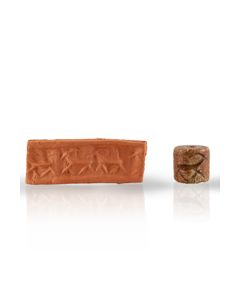 Mesopotamian cylinder seal with gazelles
Mesopotamian cylinder seal with gazellesThe seal made of nice red stone shows three gazelles walking in line. A wonderful artefact from the Jemdet Nasr period.
Price: on request Near Eastern cylinder seal with temple facade
Near Eastern cylinder seal with temple facadeThe seal shows a stunning stylized scene with a Bronze Age temple facade next to a wild animal and eyes. From Mesopotamia or south-west Iran.
Price: on request Mesopotamian cylinder seal with water creatures
Mesopotamian cylinder seal with water creaturesThe seal of light red stone shows two panels with interposed and stylized aquatic animals. Made around the onset of Bronze Age in Mesopotamia.
Price: on request Cylinder seal from Mitanni
Cylinder seal from MitanniCharacteristic art of seal engraving from the Late Bronze Age state of Mittani in present-day Syria. With animals under band of waves.
Price: on request Luristan bronze spearhead
Luristan bronze spearheadDouble-edged blade of a large spear from the Luristan region in Ancient Iran. Impressive speciment with nice patina.
Price: on request Large terra cotta female idol from Syria
Large terra cotta female idol from SyriaCharacteristic figure for the Bronze Age in the region that is today northern Syria. Dating to the 3rd or early 2nd Millennium BC.
Price: on request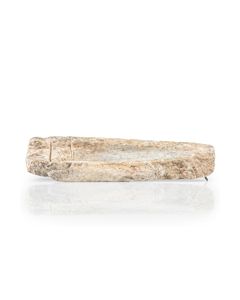 Bronze Age casting mould for a chisel
Bronze Age casting mould for a chiselOne half of a stone mould for bronze casting. The equipment is from a workshop of the 2nd Millennium BC, probably from the Carpathian Basin. From the famous Guttmann Collection. This mould was published in a work by Born and Hansen.
Price: on request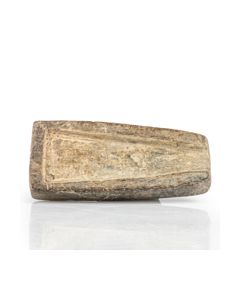 Bronze Age casting mould for a flat axe
Bronze Age casting mould for a flat axeOne half of a stone mould for bronze casting an axe head. The equipment is from a workshop of the 2nd Millennium BC, probably from the Carpathian Basin. From the famous Guttmann Collection. This mould was published in a work by Born and Hansen.
Price: on request Near Eastern lance head
Near Eastern lance headDouble-edged blade of a lance from Bronze Age. With a nice green patina.
Price: on request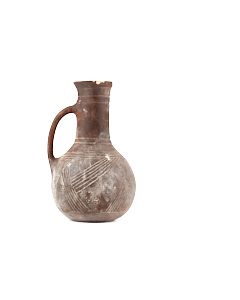 Anatolian clay jug with incised decoration
Anatolian clay jug with incised decorationThe Bronze Age vessel has wonderful linear decorative bands, the white filling of which contrasts with the dark slip. Circa 2500 to 2000 BC.
Price: on request Anatolian clay pot with lid
Anatolian clay pot with lidThe Bronze Age vessel rests on three legs and has a lid with a conical handle. Circa 2500 to 2000 BC.
Price: on request Near Eastern lance head
Near Eastern lance headDouble-edged blade of a lance from Bronze Age. Probably from Luristan in North Iran.
Price: on request Bronze Age flanged axe
Bronze Age flanged axeWorking axe from the Late Bronze Age of Europe in great condition. Typologically, it is a flanged axe head.
Price: on request Luristan bronze dagger with tang
Luristan bronze dagger with tangDouble-edged blade of a short dagger from the Luristan region in Ancient Iran. An early type from the Middle Bronze Age.
Price: on request Painted Bronze Age jug
Painted Bronze Age jugThe clay jug is decorated by an impressively well preserved geometric design. From Bronze Age Anatolia.
Price: on request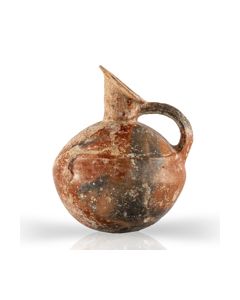 Spouted jug of the Yortan culture
Spouted jug of the Yortan cultureThe large jug has a spherical body, decorated with two stylized arms and hands. From Bronze Age Anatolia.
Price: on request Bronze Age bracelet with incised decoration
Bronze Age bracelet with incised decorationThe jewellery was made in Europe during the 2nd millennium BC. Nice, dark patina.
Price: on request Sword from the European Bronze Age
Sword from the European Bronze AgeWonderfully preserved bronze weapon from the Late Bronze Age around 1200 BC. Of the Reutlingen type, made in the region of today's Germany or surrounding countries.
Price: on request Mesopotamian stone vessel
Mesopotamian stone vesselHeavy and high quality vessel from Bronze Age of Mesopotamia, reminescent of similar Egyptian stone vessels. Ex Christie's.
Price: on request Egyptian stone bowl
Egyptian stone bowlThis wonderful and relatively large bowl of banded stone was probably used for ritual purposes. From the Early Dynastic Period or Old Kingdom of ancient Egypt.
Price: on request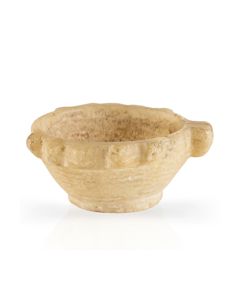 Egyptian alabaster bowl from Luxor
Egyptian alabaster bowl from LuxorThe small stone vessel is an offering bowl for libation. From the collection of Egyptologist Professor Wiedemann. 12th to 18th dynasty of Ancient Egypt
Price: on request Egyptian green stone vessel
Egyptian green stone vesselThe stone vessel is made of beautiful green serpentine. From the collection of Egyptologist Professor Wiedemann. Middle Kingdom of Ancient Egypt.
Price: on request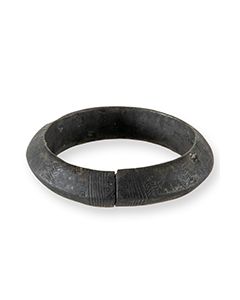 Bronze Age bracelet with incised decoration
Bronze Age bracelet with incised decorationThe jewellery was made in Europe during the 2nd millennium BC. Nice, dark patina.
Price: on request Egyptian stone vessel from Luxor
Egyptian stone vessel from LuxorThe cosmetic vessel is of a rare type. From the collection of Egyptologist Professor Wiedemann. Middle Kingdom of Ancient Egypt
Price: on request Slender Egyptian stone beaker
Slender Egyptian stone beakerThe small and tall stone vessel is made of alabaster. From the collection of Egyptologist Professor Wiedemann.
Price: on request Egyptian chalice
Egyptian chaliceThe thin-walled stone cup is reminiscent of a lotus bud. From the collection of Egyptologist Professor Wiedemann. 18th dynasty of Ancient Egypt.
Price: on request Egyptian faience figurine of Sekhmet
Egyptian faience figurine of SekhmetProtective amulet in the form of a statuette of the lion-headed goddess with a hieroglyphic inscription on the back. A wonderful and large faience from the Third Intermediate Period of Ancient Egypt.
Price: on request Egyptian stone beaker
Egyptian stone beakerThe elegant stone vase was probably used as an ointment vessel. 5th to 6th dynasty of ancient Egypt, Old Kingdom.
Price: on request Near Eastern cylinder seal
Near Eastern cylinder sealThe seal of black stone bears a scene with four noblemen or gods. Late Syrian, around 1500 BC.
Price: on request Terra cotta idol from Syria
Terra cotta idol from SyriaCharacteristic figure for the Bronze Age in the region that is today northern Syria. Dating to the 3rd or early 2nd Millennium BC.
Price: on request Mesopotamian cylinder seal
Mesopotamian cylinder sealThe marble seal bears a fight scene with lions. From the Early Dynastic or Akkadian period in the later 3rd Millennium BC.
Price: on request Egyptian model vessels of a founding ceremony
Egyptian model vessels of a founding ceremonyA group of seven miniature bowls and three miniature vases made of clay. Once filled with offerings and used ritually during a foundation stone laying ceremony. Dating to the Old Kingdom, around 2500 BC.
Price: on request Clay tablet with cuneiform text
Clay tablet with cuneiform textSmall cuneiform writing tablet with well preserved text on both sides.
Price: on request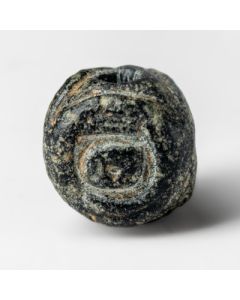 Minoan seal from the Palace Period
Minoan seal from the Palace PeriodA beautiful serpentine seal with three engraved surfaces, worn like a bead. It dates from the Old Palace Period of Crete, around 1800 BC. The piece has been studied and published in the canonical Corpus of Minoan and Mycenaean seals in 1988.
Price: on request

